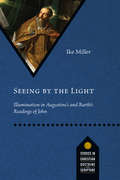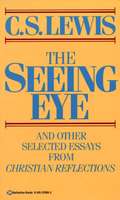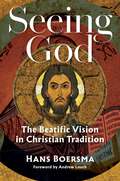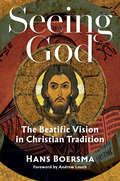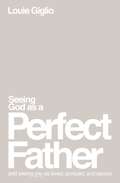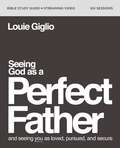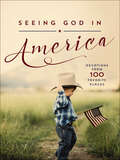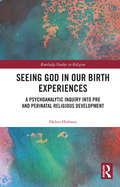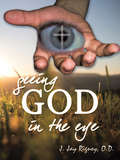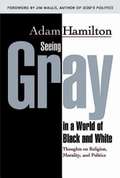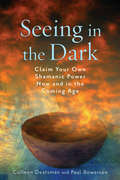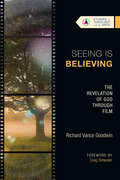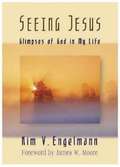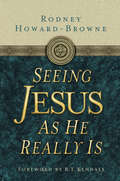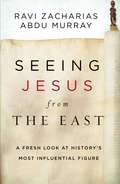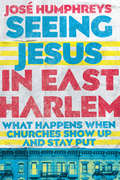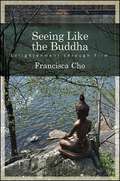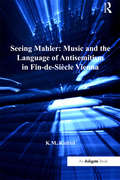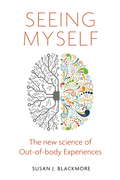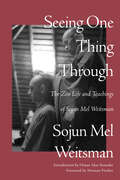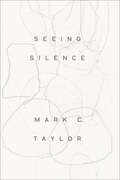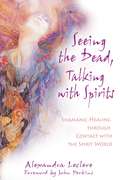- Table View
- List View
Seeing by the Light: Illumination in Augustine's and Barth's Readings of John (Studies in Christian Doctrine and Scripture)
by Ike MillerHow can we understand God's revelation to us?
Seeing God: The Beatific Vision in Christian Tradition
by Hans BoersmaTo see God is our heart’s desire, our final purpose in life. But what does it mean to see God? And exactly how do we see God—with our physical eyes or with the mind’s eye? In this informed study of the beatific vision, Hans Boersma focuses on “vision” as a living metaphor and shows how the vision of God is not just a future but a present reality. <p><p> Seeing God is both a historical theology and a dogmatic articulation of the beatific vision, of how the invisible God becomes visible to us. In examining what Christian thinkers throughout history have written about the beatific vision, Boersma explores how God trains us to see his character by transforming our eyes and minds, highlighting continuity from this world to the next. Christ-centered, sacramental, and ecumenical, Boersma’s work presents life as a never-ending journey toward seeing the face of God in Christ both here and in the world to come.
Seeing God: The Beatific Vision in Christian Tradition
by Hans BoersmaWinner of the Christianity Today Book Award in Theology/EthicsTo see God is our heart&’s desire, our final purpose in life. But what does it mean to see God? And exactly how do we see God—with our physical eyes or with the mind&’s eye? In this informed study of the beatific vision, Hans Boersma focuses on &“vision&” as a living metaphor and shows how the vision of God is not just a future but a present reality. Seeing God is both a historical theology and a dogmatic articulation of the beatific vision—of how the invisible God becomes visible to us. In examining what Christian thinkers throughout history have written about the beatific vision, Boersma explores how God trains us to see his character by transforming our eyes and minds, highlighting continuity from this world to the next. Christ-centered, sacramental, and ecumenical, Boersma&’s work presents life as a never-ending journey toward seeing the face of God in Christ both here and in the world to come.
Seeing God: The Beatific Vision in Christian Tradition
by Hans BoersmaWinner of the Christianity Today Book Award in Theology/Ethics (2019)To see God is our heart&’s desire, our final purpose in life. But what does it mean to see God? And exactly how do we see God—with our physical eyes or with the mind&’s eye? In this informed study of the beatific vision, Hans Boersma focuses on &“vision&” as a living metaphor and shows how the vision of God is not just a future but a present reality. Seeing God is both a historical theology and a dogmatic articulation of the beatific vision—of how the invisible God becomes visible to us. In examining what Christian thinkers throughout history have written about the beatific vision, Boersma explores how God trains us to see his character by transforming our eyes and minds, highlighting continuity from this world to the next. Christ-centered, sacramental, and ecumenical, Boersma&’s work presents life as a never-ending journey toward seeing the face of God in Christ both here and in the world to come.
Seeing God as a Perfect Father: and Seeing You as Loved, Pursued, and Secure
by Louie GiglioYou are chosen, loved, prized, wanted, and believed in by a perfect Father. In Seeing God as a Perfect Father, Louie Giglio invites us to experience God in a life-changing way: as a perfect Father who wants you to live under the waterfall of His blessing.How you view God informs everything about who you are and who you're becoming. In this updated and retitled edition of the national bestseller Not Forsaken, Louie Giglio challenges our common perceptions of who God is and points us to know Him as a heavenly Father who is not absent or ambivalent but is available and ready to embrace us with His approval and blessing.Seeing God as a Perfect Father invites you to:see that God is the perfection of your earthly father, not a reflection of himdiscover how to walk in the freedom of your identity as a loved child, uniquely created by Godbreak the chains of generational patterns by forgiving your imperfect family When we take hold of the truth that God has spanned heaven and earth to reach us, we will no longer be defined by our pasts but by the love of a perfect heavenly Father. When we rightly see God's character, we rightly see that we are loved, pursued, and secured by the Creator of the universe.
Seeing God as a Perfect Father Bible Study Guide plus Streaming Video: and Seeing You as Loved, Pursued, and Secure
by Louie GiglioYou are… loved, prized, wanted, believed in by a perfect FatherHow you view God informs everything about who you are and who you&’re becoming. In this powerful video Bible study, bestselling author and pastor Louie Giglio challenges our perceptions of who God is and points us to know him as a heavenly Father who is not absent or ambivalent but is available and ready to embrace you with his unconditional love and blessing.This powerful Bible study invites you to:see that God is the perfection of your earthly father, not a reflection of him;discover how to walk in the freedom of your identity as a loved child, uniquely created by God; and,break the chains of generational patterns by forgiving your imperfect family.When we take hold of the truth that God has spanned heaven and earth to reach us, we will no longer be defined by our pasts but by the love of a perfect heavenly Father. When we rightly see God&’s character, we rightly see that we are loved, pursued, and secured by the Creator of the universe.This study guide includes:Individual access to six streaming video sessionsA guide to best practices for leading a groupVideo notes and a comprehensive structure for group discussion timePersonal study section with questions and biblical passages for reflection between sessionsSessions and video run times:The Universal Craving (18:00)It&’s About What You Think (15:30)Unclouding Your View (14:30)A Better Name (17:30)Finding Freedom (19:00)Just Like Dad (19:30)This study guide has everything you need for a full Bible study experience, including:The study guide itself—with discussion and reflection questions, video notes, and a leader's guide.An individual access code to stream all video sessions online. (You don&’t need to buy a DVD!)Streaming video access code included. Access code subject to expiration after 12/31/2028. Code may be redeemed only by the recipient of this package. Code may not be transferred or sold separately from this package. Internet connection required. Void where prohibited, taxed, or restricted by law. Additional offer details inside.
Seeing God in America: Devotions from 100 Favorite Places
by Thomas NelsonWhere is your favorite place in America?Whether hiking a rocky trail up Mt. McKinley, feeling the misty spray of Niagra Falls, scanning the colorful bluebonnet fields in Texas, or smelling the sweet summer roses of Savannah, America is full of beautiful and exciting places to see and experience.Spanning our country&’s fifty states, here are 100 favorite places to visit and see up close the miraculous work of God as well as man-made masterpieces. Beautiful photography of each location is accompanied by a short devotion and prayer, nurturing gratitude and peace so often lost in the busyness of life.Perhaps some places will be familiar, bringing renewed excitement from that first visit. But, no doubt, there are new and exciting places not yet seen or even heard of, prompting next year&’s vacation destination with new explorations.If you love to travel or dream of traveling, this devotional will take you to places grand or quaint, serene or adventurous. In every corner of America, you can find the handiwork of our amazing and creative God.
Seeing God in Our Birth Experiences: A Psychoanalytic Inquiry into Pre and Perinatal Religious Development. (Routledge Studies in Religion)
by Helen HolmesThere has been a recent surge in the examination of the evolutionary roots of religious belief, all trying to identify where the human desire to seek the supernatural and the divine comes from. This book adds a new and innovative perspective to this line of thought by being the first to link prenatal and perinatal experiences to the origins of these unconscious underpinnings of our shared images of God. The book poses a ground-breaking paradigm by thinking about our earliest images of God, whether theist or atheist, within a psychoanalytic framework, comparing and contrasting the thought of Freud and Rizzuto. It looks at the issue of images of God from a diversity of psychological perspectives including, attachment theory, developmental theory and bio-psychosocial perspectives. This analysis leads to the conclusion that in parallel to postnatal findings, uterine and birth experiences can predispose individuals to form God representations later in life, through underpinning affective and environmental factors. This is a bold study of the development of one of humanity’s most fundamental aspects. As such, it will be of great interest to scholars of the psychology of religion, psychology, psychoanalysis, religious studies and early infant development.
Seeing God in the Eye: The Eye Proves Interdependent Evidence of Creation
by J. Jay Rigney, O.D.God has proven Himself so effectively to everyone that HE says there is NO EXCUSE in not believing in Him. (Romans 1: 19 & 20) Would God say that, and then not provide the proof that He exists ? This book introduces a new theory; INTERDEPENDENT EVIDENCE OF CREATION, and PROVES that theory. This book provides the PROOF you may be looking for of God’s existence. Dr. Jan Jay Rigney graduated from Northeastern State University in Tahlequah, Oklahoma in 1984. At the time of the writing of this book, he will have been in private practice Optometry for thirty-one years. While practicing Optometry, he has had the opportunity to daily, for over 35 years, observe the design, function, and intricate interworkings of the human eye.
Seeing Gray in a World of Black and White: Thoughts on Religion, Morality, and Politics
by Adam HamiltonEveryone agrees that America is polarized, with ever-hardening positions held by people less and less willing to listen to one another. No one agrees on what to do about it. One solution that hasn't yet been tried, says Adam Hamilton, is for thinking persons of faith to model for the rest of the country a richer, more thoughtful conversation on the political, moral, and religious issues that divide us. Hamilton rejects the easy assumptions and sloppy analysis of black and white thinking, seeking instead the truth that resides on all sides of the issues, and offering a faithful and compassionate way forward. He writes, "I don't expect you to agree with everything I've written. I expect that in the future even I won't agree with everything I've written here. The point is not to get you to agree with me, but to encourage you to think about what you believe. In the end I will be inviting those of you who find this book resonates with what you feel is true, to join the movement to pursue a middle way between the left and the right - to make your voices heard - and to model for our nation and for the church, how we can listen, learn, see truth as multi-sided, and love those with whom we disagree." Read more about this title Adam Hamilton's Seeing Gray Blog Now available! Seeing Gray in a World of Black and White - DVD UPC: 843504001902 A five-session video resource featuring Adam Hamilton teaching these concepts on DVD for group or individual study. Includes leader's guide as well as bonus video. Click below to view a preview of each video session. Where Faith and Politics Meet Christ Christians and the Culture Wars How should we live, The Ethics of Jesus Spiritual Maturity and Seeing Gray What Would Jesus Say to America?
Seeing in the Dark
by Colleen DeatsmanThe word "shaman" means "one who sees in the dark." Shamans consciously choose to live in two different worlds at the same time. They have one foot here in the everyday world and one foot in the world of the spirits. The fact is, we all live in these two different worlds, but are commonly not aware of the other, less visible one. This world does not exist in some other place, but is right beside us, just outside of our usual perceptions. Seeing in the Dark is a definitive source for personal shamanism and not only provides the tools and techniques of the shaman, but presents the wisdom tradition, awareness paradigm, and shamanic way of life. The powerful shamanic path has weathered the cataclysmic changes of over 50,000 years of human history and is even more vital and relevant today. In times when stress, tension, and the fast pace of life overwhelm us, this path shows us how to slow down, reconnect to the sacred, and harness our personal power--skills that will be needed for the uncertain days ahead. Included in this book are over 100 easy-to-follow exercises that teach important survival skills for the coming changes of 2012 and beyond.
Seeing Is Believing: The Revelation of God Through Film (Studies in Theology and the Arts Series)
by Richard Vance GoodwinHow might film reveal God?In its most basic form, film is a series of images displayed over time. Of course, film has developed greatly since the Lumière brothers by adding components such as sound, special effects, digital recording, and more to create an increasingly complex artistic medium. Historically, film studies has often focused on the narrative aspect of film as it seeks to tell a story. More recent studies, however, have turned attention to other elements of film, such as the musical score. Yet, film remains, in a sense, a series of images.In this study, the latest in IVP Academic's Studies in Theology and the Arts (STA) series, theologian Richard Goodwin considers how the images that constitute film might be a conduit of God's revelation. By considering works by Carl Theodor Dreyer, Stanley Kubrick, Paul Thomas Anderson, Robert Bresson, Martin Scorsese, Terrence Malick, and more, Goodwin argues that by inviting emotional responses, film images can be a medium of divine revelation.Blessed are those who have seen God... through film.
Seeing Jesus: Glimpses of God in My Life
by Kim V. EngelmannSeeing Jesus contains a series of short reflections that help the reader see God at work in our daily lives. Though Jesus is an ever-present reality in our lives, we often fail to recognize his presence in the midst of life's storms and difficulties. Through metaphor and story (both biblical and personal anecdotes), Engelmann reminds us that we are surrounded by, sustained by, and empowered by a God who is intimately present in and through all of life's experiences. Learning to "see Jesus," to recognize Jesus' presence in our lives, is a lifelong process. Contents:Seeing Jesus by Expanding Your ContextSeeing Jesus in Letting Go of What We Cling ToSeeing Jesus in the UnexpectedSeeing Jesus When He Seems Far AwaySeeing Jesus in the StormsSeeing Jesus in the Acorns and Mustard SeedsSeeing Jesus in When You Are Out on a LimbSeeing Jesus In the Master FiddlerSeeing Jesus in Suffering "The miracles of God are all around us but can we see them? People to help, opportunities to serve, and lessons to learn are all around us, but do we see them? The redemptive activities of Jesus Christ are happening all around us, but do we notice? Do we take them in? Can we really see them with our eyes, our minds, our hearts? Dr. Engelmann encourages us to 'open our eyes' and see the presence of Jesus." --from the Foreword by James W. Moore
Seeing Jesus as He Really Is
by Rodney Howard-BrowneSeeing Jesus as He Really Is takes you on a journey through the Gospels and along the way, you'll see how Jesus really lived, how He radically changed the world, and how Jesus is portrayed through the word of God.Seeing Jesus as He Really Is will help every reader know how to answer the questions that Jesus asked His disciples, "Whom do men say that I am" and "Who do you say that I am?"Chapters include: Jesus and His Methods; The Sweet Presence of Jesus; The Name of Jesus; Called to Do the Works of Jesus; Pressing in to Jesus.
Seeing Jesus from the East: A Fresh Look at History’s Most Influential Figure
by Ravi Zacharias Abdu MurrayEncounter Jesus Like Never Before through Eastern EyesThroughout these pages, Ravi Zacharias and Abdu Murray invite readers to rediscover the cultural insights we often miss when we ignore the Eastern context of the Bible. They offer a refreshing picture of Jesus, one that appeals to Eastern readers and can penetrate the hearts and imaginations of postmodern Westerners.In Seeing Jesus from the East, Ravi Zacharias and Abdu Murray show us why a broader view of Jesus is needed - one that recognizes the uniquely Eastern ways of thinking and communicating found in the pages of the Bible. Zacharias and Murray capture a revitalized gospel message, presenting it through this Eastern lens and revealing its power afresh to Western hearts and minds.Incorporating story, vivid imagery, and the concepts of honor and shame, sacrifice, and rewards, Seeing Jesus from the East calls believers and skeptics, both Eastern and Western, to a fresh encounter with the living and boundless Jesus.
Seeing Jesus in East Harlem: What Happens When Churches Show Up and Stay Put
by José HumphreysWe are all located in different places. And the way we grow as disciples and lead others in spiritual growth depends on our contexts. Pastor José Humphreys recognizes how deeply our faith is tied to our particular stories in our particular places. Grounded in his own deep faith and wisdom, he writes out of his experiences as a Puerto Rican pastor who has planted a multiethnic church in East Harlem. In this book, he offers a framework to help church leaders take discipleship seriously in their places, calling them to show up, stay put, and see what God is doing in their midst. Combining spiritual formation with activism, vivid narrative with exhortation, and realism with hopefulness, Humphreys offers pastors and church planters a thoughtful look at discipleship in a complex world.
Seeing Like the Buddha: Enlightenment through Film
by Francisca ChoIn this important new contribution to Buddhist studies and Buddhist film criticism, Francisca Cho argues that films can do more than simply convey information about Buddhism. Films themselves can become a form of Buddhist ritual and contemplative practice that enables the viewer not only to see the Buddha, but to see like the Buddha. Drawing upon her extensive knowledge of both Buddhism and film studies, Cho examines the aesthetic vision of several Asian and Western films that explicitly or implicitly embody Buddhist teachings about karma, emptiness, illusion, and overcoming duality. Her wide-ranging analysis includes Spring, Summer, Fall, Winter … and Spring (South Korea, 2003), Nang Nak (Thailand, 1999), Rashomon (Japan, 1950), Maborosi (Japan, 1995), and the films of American Terrence Malick.
Seeing Mahler: Music and the Language of Antisemitism in Fin-de-Siècle Vienna
by K.M. KnittelNo-one doubts that Gustav Mahler's tenure at the Vienna Court Opera from 1897-1907 was made extremely unpleasant by the antisemitic press. The great biographer, Henry-Louis de La Grange, acknowledges that 'it must be said that antisemitism was a permanent feature of Viennese life'. Unfortunately, the focus on blatant references to Jewishness has obscured the extent to which 'ordinary' attitudes about Jewish difference were prevalent and pervasive, yet subtle and covert. The context has been lost wherein such coded references to Jewishness would have been immediately recognized and understood. By painstakingly reconstructing 'the language of antisemitism', Knittel recreates what Mahler's audiences expected, saw, and heard, given the biases and beliefs of turn-of-the-century Vienna. Using newspaper reviews, cartoons and memoirs, Knittel eschews focusing on hostile discussions and overt attacks in themselves, rather revealing how and to what extent authors call attention to Mahler's Jewishness with more subtle language. She specifically examines the reviews of Mahler's Viennese symphonic premieres for their resonance with that language as codified by Richard Wagner, though not invented by him. An entire chapter is also devoted to the Viennese premieres of Richard Strauss's tone poems, as a proof text against which the reviews of Mahler can also be read and understood. Accepting how deeply embedded this way of thinking was, not just for critics but for the general population, certainly does not imply that one can find antisemitism under every stone. What Knittel suggests, ultimately, is that much of early criticism was unease rather than 'objective' reactions to Mahler's music - a new perspective that allows for a re-evaluation of what makes his music unique, thought-provoking and valuable.
Seeing Myself: What Out-of-body Experiences Tell Us About Life, Death and the Mind
by Susan BlackmoreEssential reading for anyone seeking to understand their own mind and to find a spiritual path that is compatible with scienceAs an impressionable young student, Susan Blackmore had an intense, dramatic and life-changing experience, seeming to leave her body and travel the world. With no rational explanation for her out-of-body experience (OBE) she turned to astral projection and the paranormal, but soon despaired of finding answers. Decades later, a Swiss neurosurgeon accidentally discovered the spot in the brain that can induce OBEs and everything changed; this crucial spot is part of the brain's self-system and when disturbed so is our experience of self. Blackmore leaped back into OBE research and at last began to unravel what had happened to her. Seeing Myself describes her long quest for answers through spirituality, religion, drugs, meditation, philosophy and neuroscience.Anyone can have an OBE, indeed 15 per cent of us have. Even more have experienced sleep paralysis, lucid dreaming and the creepy sense of an invisible presence. At last, with the advent of brain stimulation, fMRI scanning and virtual reality, all these phenomena are beginning to make sense. Long relegated to the very fringes of research, the new science of out-of-body experiences is now contributing to our understanding of consciousness and our very selves.
Seeing Myself: What Out-of-body Experiences Tell Us About Life, Death and the Mind
by Susan BlackmoreEssential reading for anyone seeking to understand their own mind and to find a spiritual path that is compatible with scienceAs an impressionable young student, Susan Blackmore had an intense, dramatic and life-changing experience, seeming to leave her body and travel the world. With no rational explanation for her out-of-body experience (OBE) she turned to astral projection and the paranormal, but soon despaired of finding answers. Decades later, a Swiss neurosurgeon accidentally discovered the spot in the brain that can induce OBEs and everything changed; this crucial spot is part of the brain's self-system and when disturbed so is our experience of self. Blackmore leaped back into OBE research and at last began to unravel what had happened to her. Seeing Myself describes her long quest for answers through spirituality, religion, drugs, meditation, philosophy and neuroscience.Anyone can have an OBE, indeed 15 per cent of us have. Even more have experienced sleep paralysis, lucid dreaming and the creepy sense of an invisible presence. At last, with the advent of brain stimulation, fMRI scanning and virtual reality, all these phenomena are beginning to make sense. Long relegated to the very fringes of research, the new science of out-of-body experiences is now contributing to our understanding of consciousness and our very selves.
Seeing One Thing Through: The Zen Life and Teachings of Sojun Mel Weitsman
by Mel WeitsmanA young painter, coming of age in San Francisco&’s bohemian 1950s, meets his teacher—Shunryu Suzuki, a pivotal figure in Buddhist America—and dedicates his life to continuing Suzuki Roshi&’s teachingsSeeing One Thing Through begins with a series of autobiographical memories and reflections going back to Sojun Mel Weitsman&’s boyhood in Southern California, his coming of age as an artist and a seeker in the vibrant San Francisco of the 1950s, and his encounter with Zen in one remarkable teacher, Shunryu Suzuki Roshi. From that moment, and for nearly sixty years after, Weitsman&’s life took the direct path of Zen—as a student, as a teacher, and as one of the first generations of American Zen masters. The larger portion of the book is a collection of Weitsman&’s edited talks, his articulation of &“ordinary mind,&” and his strong belief that Zen as a way of life is available to all.
Seeing Silence
by Mark C. Taylor“To hear silence is to find stillness in the midst of the restlessness that makes creative life possible and the inescapability of death acceptable.” So writes Mark C. Taylor in his latest book, a philosophy of silence for our nervous, chattering age. How do we find silence—and more importantly, how do we understand it—amid the incessant buzz of the networks that enmesh us? Have we forgotten how to listen to each other, to recognize the virtues of modesty and reticence, and to appreciate the resonance of silence? Are we less prepared than ever for the ultimate silence that awaits us all? Taylor wants us to pause long enough to hear what is not said and to attend to what remains unsayable. In his account, our way to hearing silence is, paradoxically, to see it. He explores the many variations of silence by considering the work of leading modern and postmodern visual artists, including Barnett Newman, Ad Reinhardt, James Turrell, and Anish Kapoor. Developing the insights of philosophers, theologians, writers, and composers, Taylor weaves a rich narrative modeled on the Stations of the Cross. His chapter titles suggest our positions toward silence: Without. Before. From. Beyond. Against. Within. Between. Toward. Around. With. In. Recasting Hegel’s phenomenology of spirit and Kierkegaard’s stages on life’s way, Taylor translates the traditional Via Dolorosa into a Nietzschean Via Jubilosa that affirms light in the midst of darkness. Seeing Silence is a thoughtful meditation that invites readers to linger long enough to see silence, and, in this way, perhaps to hear once again the wordless Word that once was named “God.”
Seeing the Dead, Talking with Spirits: Shamanic Healing through Contact with the Spirit World
by Alexandra Leclere John PerkinsRecounts one woman's discovery of her ability to heal through contact with spirits and reveals how others can awaken this same gift in their own lives • Explains how reconnecting with our inner sense of joy is the first step in healing • Shows how to rid our life of the traumas from the past that hinder our spiritual development, including unresolved traumas from past lives • Provides a roadmap that others can use for rediscovering their own connections to the spirit world Like many others who have discovered that they have a healing vocation, Alexandra Leclere began meeting with other healers and shamans to learn how to put her gift to use. At one of these gatherings she was shocked to find that she was the only one who could see the spirit of a deceased woman that was being honored there--a sign that marked the beginning of a remarkable adventure that taught her how to use her gift for healing herself and others. Despite the extraordinary powers of clairsentience and clairvoyance revealed to her through her work with the spirit world, Alexandra Leclere shows that the greatest gift she has received since her shamanic awakening is the ability to experience unconditional joy. Often the pain caused by unresolved psychological traumas from the past--including past lives--is the key obstacle restricting access to the powers offered by the spirits. The first step in healing requires reconnecting with the joy that resides within us. Once this connection has been established, we are all capable of restoring our connection to the spirit world. Alexandra Leclere’s story provides a roadmap for finding our way back.
Seeing the Invisible God: Studies in the Gospel of John
by Carol Brown[From the back of the book:] "Our God wants us to know Him. He sent His Son to us as "the Word." the ultimate revelation of God to human beings. With the availability of John's gospel, we don't have much excuse for not knowing Him. for John records how God's Son, in His walk on earth as the man Jesus Christ, explained and demonstrated to us the invisible God. In this unique 10-lesson study of some of Christ's "I am" statements, we "see" the One He came to reveal and are challenged to live in light of that knowledge." Each study contains an introduction and summary. There are questions about the content siting the verses where the answers can be found. Each study contains the following three sections comprised of 1 to three questions/prompts: We want to see Jesus, Show us the Father and Personal application. There are leader's notes at the end with additional guidance and information about specific questions from all of the studies.
